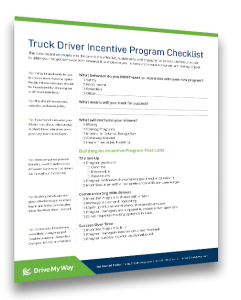
In today’s trucking industry, it takes more than just a strong pay rate to win over top talent. Drivers are carefully weighing the full package when deciding where to work, and whether to stay.
While competitive wages are still important, benefits play an increasingly critical role in attracting qualified drivers and keeping them behind the wheel. From health insurance and retirement plans to pet policies and mental health support, drivers are looking for employers that meet both their personal and professional needs.
Understanding what drivers expect, and what’s beginning to stand out as an industry differentiator, is essential for companies looking to recruit top talent and build long-term loyalty.
The Core Benefits Truck Drivers Expect
While job priorities may shift over time, the foundation of a strong benefits package remains consistent. Drivers still expect the basics: benefits that support their financial and personal well-being.
Here are the core benefits that truck drivers continue to view as non-negotiables:
- Health Insurance: Comprehensive medical, dental, and vision coverage is a top concern for many drivers. The high-risk nature of the job, long hours, and time away from home make this especially important.
- 401(k) with Company Match: Many experienced drivers are thinking long term. Retirement savings plans, especially with employer contributions, can be a major incentive for retention.
- Paid Time Off (PTO): Whether it’s vacation days, sick leave, or paid holidays, drivers want to know they’ll have structured time to rest and reconnect with family.
- Life Insurance and Disability Coverage: These benefits provide peace of mind for drivers and their families, especially in an industry where accidents and injuries are unfortunately part of the risk.
- Detention, Layover, and Breakdown Pay: Drivers expect compensation for delays or mechanical issues that eat into their hours and earnings. These are quickly becoming essential for companies, not just an optional benefit.
Emerging Benefits Gaining Traction in 2025
While the basics form the foundation, newer and more flexible benefits are becoming key differentiators, especially among younger drivers or those looking to change fleets.
Many of these trends align with broader workforce priorities around work-life balance and overall wellness.
Mental Health and Wellness Support
The isolation and stress of life on the road can take a serious toll on drivers. To better support drivers on and off the road, many fleets now provide:
- Access to virtual therapy or mental health hotlines
- Employee Assistance Programs (EAPs)
- Wellness stipends for activities like yoga, meditation apps, or gym memberships
Flexible Home Time and Scheduling
In an industry where home time has long been a sticking point, providing flexibility has become a major factor in recruiting drivers. Companies that can offer regional or hybrid routes, predictable schedules, or more control over time off have a clear advantage.
Pet and Rider Policies
Truckers often want companionship on the road. Fleets that allow pets, or even subsidize pet insurance, can appeal to drivers who don’t want to leave furry friends behind.
Similarly, rider policies that allow a spouse, child, or friend to join a driver on the road can ease the strain of time away from home. These programs help drivers stay connected to loved ones and make long stretches on the road feel less isolating.
Bonuses Beyond Sign-On
Sign-on bonuses still exist, but today’s drivers know they often come with strings attached. Because of this, many companies are finding greater success by focusing on ongoing, performance-based incentives such as:
- Performance Bonuses (based on safety, fuel efficiency, or customer feedback)
- Tenure Bonuses to reward long-term loyalty
- Referral Bonuses that tap into driver networks
Unique and Creative Benefits That Stand Out
If you’re looking to differentiate yourself from competitors, offering benefits that go beyond the norm can make a significant impact.
Some creative benefits that are growing in popularity include:
- Education Reimbursement or CDL School Loan Assistance: Helping drivers earn or maintain credentials, or even support continuing education outside trucking, can show your investment in their future.
- Health Club or Subscription Perks: Subsidies for gym memberships, healthy meal delivery, or subscriptions like Spotify or Audible can help make life on the road more enjoyable and healthier.
- Guaranteed Pay Programs: New drivers often cite income instability as a challenge. Guaranteed pay during training or slow periods helps reduce stress and build trust.
- Retirement Planning Resources: Beyond just offering a 401(k), some fleets now provide access to financial planning tools or advisors to help drivers manage long-term goals.
- Tech-Friendly Perks: Access to modern trucks with up-to-date technology, mobile-friendly communication tools, and efficient dispatch software helps younger or tech-savvy drivers feel supported.
For more ways to stay ahead of the curve in the transportation industry in 2025, be sure to check out the rest of our Employer Blog posts and connect with us on social media.











 Medical benefits, life insurance, retirement benefits, and disability insurance
Medical benefits, life insurance, retirement benefits, and disability insurance  Learning and development offerings are a wealth of opportunities for drivers. Many potential employees will be particularly excited to find a company that supports their professional growth. Whether you offer compensation for educational assistance programs or regularly facilitate
Learning and development offerings are a wealth of opportunities for drivers. Many potential employees will be particularly excited to find a company that supports their professional growth. Whether you offer compensation for educational assistance programs or regularly facilitate  “The culture of a family owned business that values their people, treats them with respect, and works well together as a team is what makes us successful and provides a more positive experience for the driver. We have late model equipment, high quality shops, and a great customer base, but in the end it is people that make it all work.”
“The culture of a family owned business that values their people, treats them with respect, and works well together as a team is what makes us successful and provides a more positive experience for the driver. We have late model equipment, high quality shops, and a great customer base, but in the end it is people that make it all work.”







